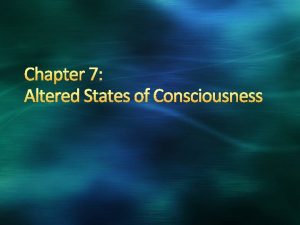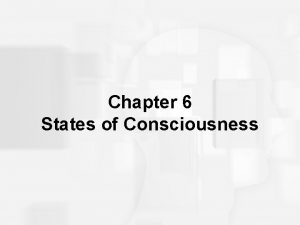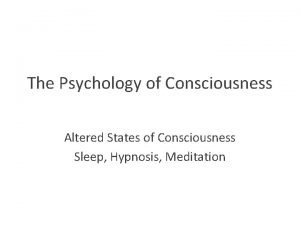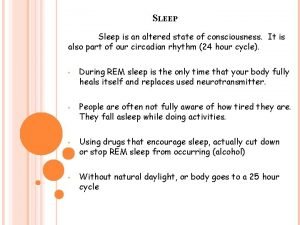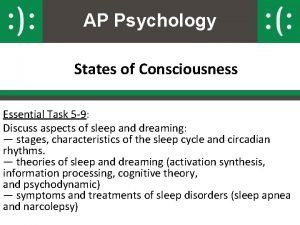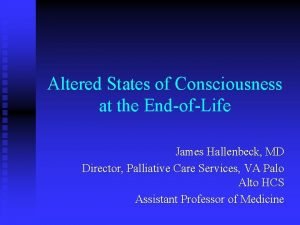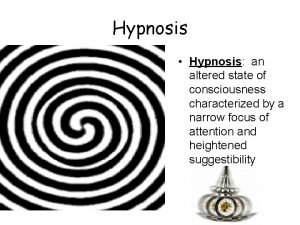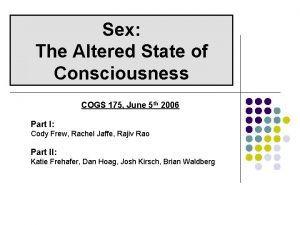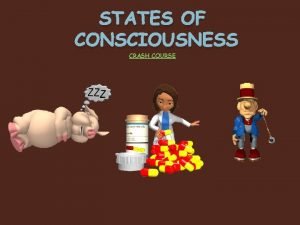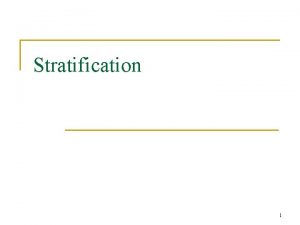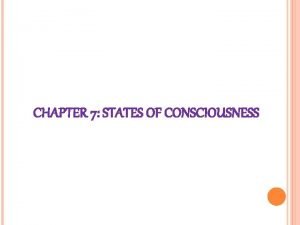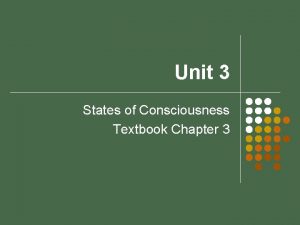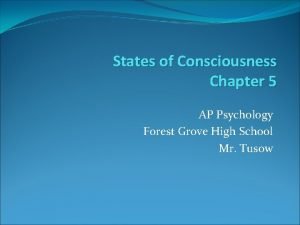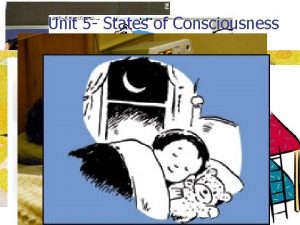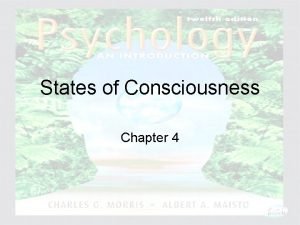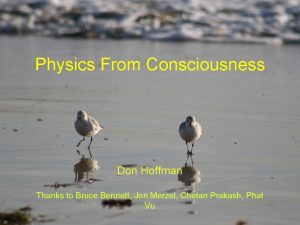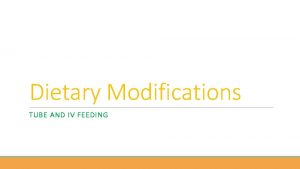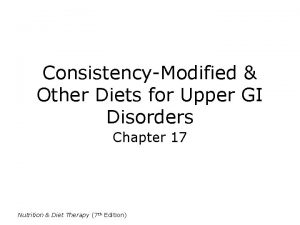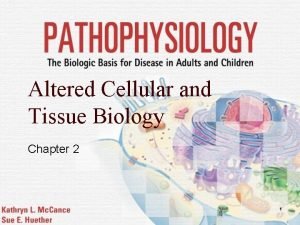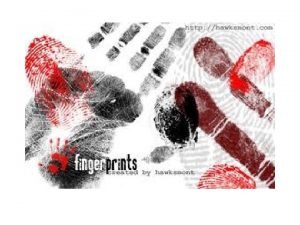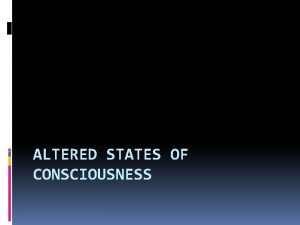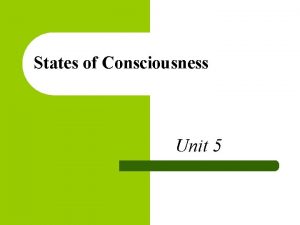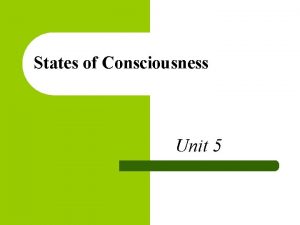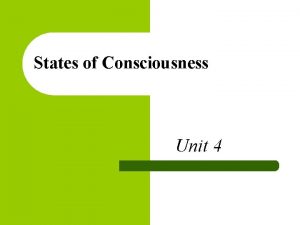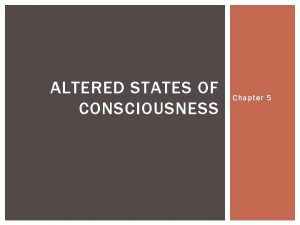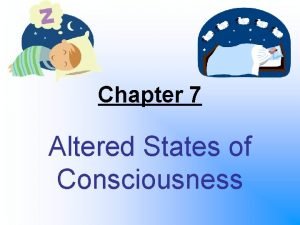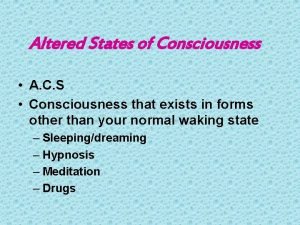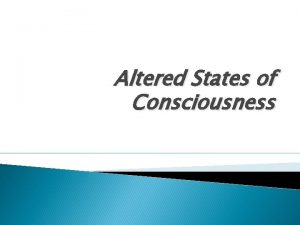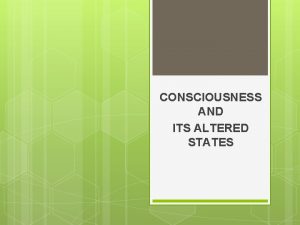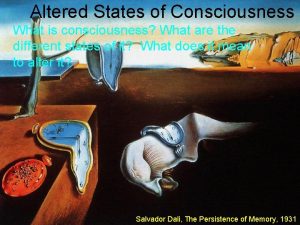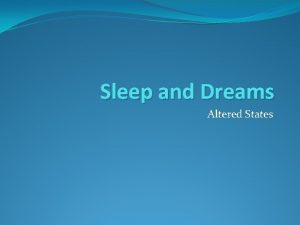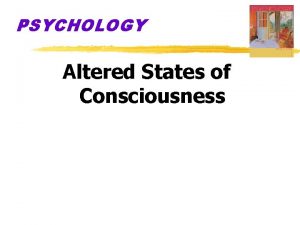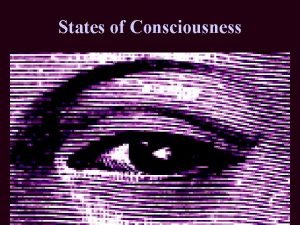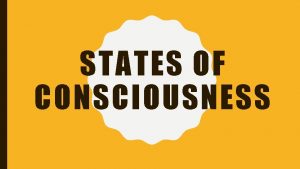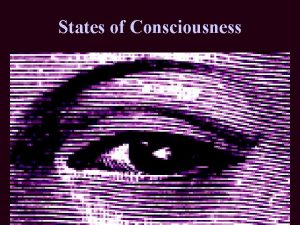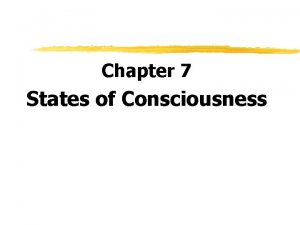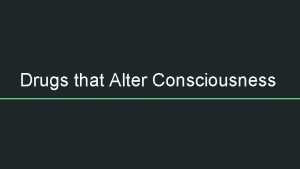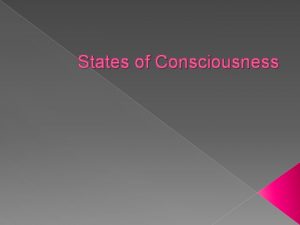Chapter 7 Altered States of Consciousness Consciousness Is




























- Slides: 28

Chapter 7: Altered States of Consciousness

Consciousness Is a state of awareness Can range from alertness to nonalertness A person who is not aware of what is going on is in an altered state of consciousness

What is Sleep? Characterized by lack of mobility or unresponsiveness to the environment A state of altered consciousness, characterized by certain patterns of brain activity and inactivity Vital to mental health Restorative – allows the brain to recover from exhaustion and stress while the body conserves energy.

Studying Sleep Has been very difficult until recently A researcher can not have a sleeping person report without waking them; thus making the study invalid EEG or electroencephalography is a device that records the electric activity of the brain

Stage of Sleep: Stage I Lightest level of sleep – “just drifting” Pulse slows and muscles relax Breathing becomes uneven and brain waves grow irregular Lasts for up to 10 minutes EEG brain waves is marked by the presence of theta waves (lower in amplitude and frequency than alpha waves)

Stages of Sleep – Stage II Brain waves shift from low-amplitude, high frequency to high-amplitude, low frequency waves (this pattern means you have entered this stage) Eyes roll slowly from side to side Slight decrease in body temperature Usually lasts about 30 minutes

Stages of Sleep – Stage III Characterized by large-amplitude delta waves which begin to sweep your brain almost every second

Stages of Sleep – Stage IV Deepest sleep of all Very difficult to awaken – would feel disoriented Large, regular delta waves occur 50% of the time when you are in this stage of sleep – state of oblivion Sleepwalking, bedwetting, talking out loud most likely to occur

Stages of Sleep Stages 1 -4 known as “quiet sleep” Stages 1 -4 also referred to as NREM (Non-Rapid Eye Movement) 75% of sleep time is spent in stages 1 -4 Deep sleep is important to your physical or psychological well-being Go through sleep cycles every 90 minutes

Stages of Sleep - REM Called active sleep Characterized by rapid eye movements, a high level of brain activity, a deep relaxation of the muscles Large muscles in arms & legs paralyzed Pulse rate and breathing become irregular Dreams take place during this stage Lasts for 15 -45 minutes At no point in your sleep, does the brain become totally inactive

How much sleep? Your will spend 1/3 of your life sleeping Varies from individual to individual and from time to time in your life Circadian rhythm- is a biological clock that is genetically programmed to regulate physiological responses within a time period of 24 -25 hours Without any environmental cues, people have still kept their circadian cycle

Sleep Disorders - Insomnia The failure to get enough sleep at night in order to feel rested the next day Some people with this disorder rarely get more than and hour or two of uninterrupted sleep Anxiety, depression, overuse of alcohol or drugs can cause insomnia

Sleep Disorders – Sleep Apnea Affects more than 12 million Americans A disorder in which a person has trouble breathing while sleeping Usually caused by a physical problem instead of mental stress Specific kind of snoring that may occur hundreds of times per night Each episode lasts 10 -15 seconds and ends suddenly, usually with a physical movement of the body

Sleep Disorders - Narcolepsy Is a condition characterized by suddenly falling asleep or feeling very sleepy during the day May have sleep attacks during the day Victims usually have a problem with work, leisure, and interpersonal activities Prone to accidents

Sleep Disorders – Nightmares & Night Terrors Nightmares - Unpleasant dreams that occur during REM sleep Night terrors Sleep disruptions that occur during Stage IV of sleep, involving screaming, panic, or confusion Last from 5 -25 minutes Involve rapid heart rate, screaming, sweating, and confusion Usually have no memory of them

Dreams are the mental activity that takes place during sleep. Because the amounts of time spent in REM sleep increase during the night, the last dream is likely to be the longest and the one people remember when they wake up. A large percentage of the emotions experienced in dreams are negative or unpleasant – anxiety, anger, sadness, etc… Some dreams are negative enough to be considered nightmares.

Sleep Disorders – Sleepwalking Walking or carrying out behaviors while asleep Mostly associated with children (usually will outgrow it) Usually harmless, unless the victim falls or hurts himself Person may walk or do other things without any memory of doing so

Sleep Disorders – Sleep Talking A common sleep disruption Can occur in REM and NREM sleep The sleep talker sometimes pauses as if he or she is having a conversation You can engage in a conversation with a sleep talker



Section 2: Hypnosis, Biofeedback, Hypnosis is a form of altered consciousness in which people become highly suggestible to changes in behavior and thought. and. Participants Meditation are NOT put to sleep – it is a form of trance. Hypnosis has uses in medical and therapeutic settings. Memory can be aided or enhanced Pain can be eliminated or reduced Problems can be revealed and insight gained

Biofeedback is a technique in which a person learns to control physiological processes with the help of feedback. Can control processes such as heart rate, blood pressure, skin temperature, and sweat-gland activity

Meditation is when a person focuses his or her attention on an image or thought to clear the mind and produce relaxation. 3 types Transcendental : involves the mental repetition of a mantra Mindfulness : focuses on the present moment (a Buddhist tradition) Breath : concentration on respiration – inhaling and exhaling


Section 3: Drugs and Consciousness Psychoactive Drugs Interact with the central nervous system to alter a person’s mood, perception, and behavior. Range from stimulants (like caffeine in coffee/cola) to depressants (like alcohol) to hallucinogens (like marijuana and LSD). Enter the blood stream and are taken up in target tissues in various parts of the body

Marijuana Effects differ from person to person and can be pleasant or unpleasant. Studies suggest that it is more damaging to the lungs than cigarette use. Disrupts memory formation, making it difficult to carry out mental and physical tasks. Hallucinogens Main effect is the production of hallucinations. Also called psychedelics because they create a loss of contact with reality. The most potent hallucinogen is LSD.

Opiates Usually called narcotics Includes opium, morphine, and heroin Produce analgesia (pain reduction) and euphoria. Alcohol Is the most widely used and abused mind-altering substance in the U. S. Effects depend on the amount, frequency, and body weight of the drinker. Effects are slurred speech, blurred vision, impaired judgment and memory.

Drug Abuse and Treatment Drug abusers are people who regularly use illegal drugs or excessively use legal drugs. Risks of abuse are danger of death or injury, damage to health, legal consequences, destructive behavior, and loss of control. Treatment requires the individual to 1) admit they have a problem 2) enter a treatment program or get therapy 3) join a support group to help reduce the possibility of a relapse.
 Consciousness def
Consciousness def Chapter 7 altered states of consciousness
Chapter 7 altered states of consciousness Lesson quiz 7-1 altered states of consciousness
Lesson quiz 7-1 altered states of consciousness Altered state of consciousness psychology
Altered state of consciousness psychology An altered state of consciousness
An altered state of consciousness Sleep theories ap psychology
Sleep theories ap psychology Altered state of consciousness psychology
Altered state of consciousness psychology Altered state of consciousness psychology
Altered state of consciousness psychology Hypnotic states
Hypnotic states Sex altered state of consciousness
Sex altered state of consciousness Crash course states of consciousness
Crash course states of consciousness Altered states game
Altered states game Horizontal mobility
Horizontal mobility 7: states of consciousness psychology
7: states of consciousness psychology Chapter 7 states of consciousness
Chapter 7 states of consciousness 3 states of consciousness
3 states of consciousness Latent dreams definition
Latent dreams definition Unit 5 states of consciousness answers
Unit 5 states of consciousness answers Ap psychology states of consciousness
Ap psychology states of consciousness Unit 5 states of consciousness
Unit 5 states of consciousness What were the 11 free states
What were the 11 free states Southern states
Southern states Tyranny
Tyranny Modular tube feeding
Modular tube feeding Dietary adjustments after a gastrectomy are influenced by
Dietary adjustments after a gastrectomy are influenced by Altered cognition in older adults is commonly attributed to
Altered cognition in older adults is commonly attributed to Altered cellular and tissue biology
Altered cellular and tissue biology Corrected cast technique
Corrected cast technique Can fingerprints be altered or disguised how
Can fingerprints be altered or disguised how

